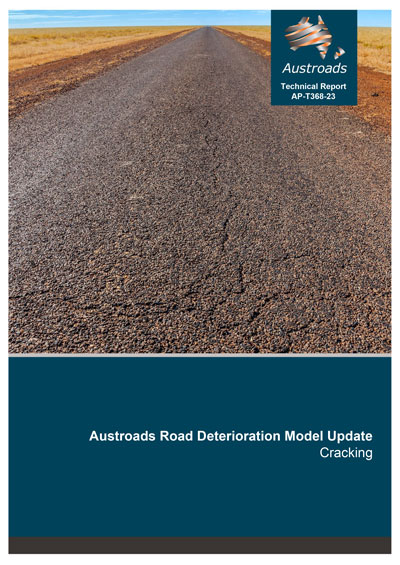Pavement

- Publication no: AP-T368-23
- ISBN: 978-1-922700-68-1
- Published: 20 January 2023
- PDF (free) Download
This report documents a project designed to update the current Austroads road deterioration (RD) models using the long-term pavement performance and long-term pavement performance maintenance (LTPP/LTPPM) dataset and other data available, such as the traffic sped deflectometer (TSD) datasets, to improve these models’ explanatory power.
The cracking RD model documented in this report was based on a mechanistic-empirical, deterministic approach using a multi-variate non-linear regression (MVNLR) analysis. The cracking RD model uses cumulative cracking as the dependent variable for thinly surfaced flexible unbound granular pavements. The model was developed using the New South Wales dataset collected by the TSD from 2014 to 2018. The cracking RD model will need calibration to suit locally observed cracking conditions as location has a bearing on the rates of cracking progression.
Watch a webinar with Dr Tim Martin, Ranita Sen and Tyrone Toole for an overview of the development of the four road deterioration models.
- Summary
- 1. Introduction
- 1.1 Background
- 1.2 Purpose
- 1.3 Scope
- 1.4 Methodology
- 2. Literature Review
- 2.1 Overview
- 2.2 Pavement Performance
- 2.2.1 Limit of Gradual Deterioration
- 2.3 Assessment of Pavement Performance
- 2.3.1 Functional Performance Measures
- 2.3.2 Structural Indicators
- 2.4 Review of Recent Modelling Practice
- 2.4.1 Typical Modelling Approaches
- 2.4.2 Machine Learning with Big Datasets
- 2.4.3 Application of ML to Pavement Deterioration Modelling
- 2.5 Selection of Appropriate Modelling Approaches
- 2.5.1 Expected Modelling Approach
- 2.5.2 Proof of Concept for TSD Datasets
- 3. Data Review
- 3.1 Data for Analysis
- 3.2 Data Requested from Road Agencies
- 3.3 Review of the Data from Australian Road Agencies
- 3.3.1 Transport for New South Wales (TfNSW) Data
- 3.3.2 Queensland Department of Transport and Main Roads (TMR) Data
- 3.3.3 Main Roads Western Australia (MRWA) Data
- 3.3.4 Department of Planning, Transport and Infrastructure (DPTI) South Australia Data
- 3.3.5 Department of Infrastructure, Planning and Logistics (DIPL) Northern Territory Data
- 3.3.6 Department of State Growth (DSG) Tasmania Data
- 3.3.7 Summary of Road Agency Data Supplied
- 3.4 Missing Data for RD Model Development
- 3.4.1 Climate Information
- 3.4.2 Soil Reactivity
- 3.4.3 Sub-soil Drainage Information
- 3.4.4 Additional Information Supplied by TfNSW
- 3.5 Review of the LTPP/LTPPM Data
- 3.5.1 Overview of Austroads LTPP/LTPPM Data
- 3.5.2 Usability of Austroads LTPP/LTPPM Data
- 3.5.3 Usability of New Zealand LTPP Data
- 4. Development of the Cracking RD Model
- 4.1 General Approach and Limitations
- 4.1.1 Data Summary
- 4.2 Treatment of Independent Variables
- 4.3 Development of the Cracking RD Model
- 4.3.1 Design Deflection D0 based on the D0/D0i Structural RD Model
- 4.3.2 Estimation of Cracking Age, crxAGE, of the TSD Cracking Data
- 4.4 Cumulative Cracking, ΣΔcrx, RD Model Development
- 4.4.1 The Cracking RD Model
- 4.4.2 Annual Incremental Cracking
- 4.4.3 Comparison with Austroads 2010 Cracking RD Model
- 4.4.4 Potential for Further Refinement of Cumulative Cracking Prediction
- 4.1 General Approach and Limitations
- 5. Conclusions
- References
- Appendix A Multivariate Non-Linear Regression Analysis Outputs
- A.1 Cumulative Cracking, ΣΔcrx, RD Model
